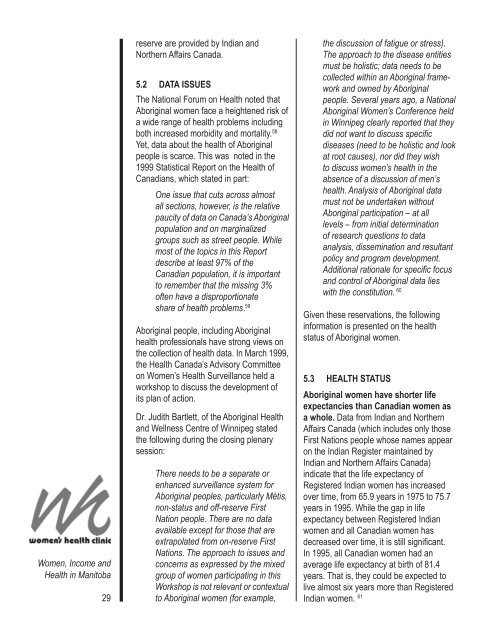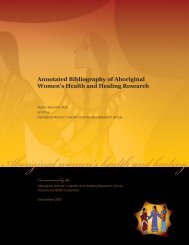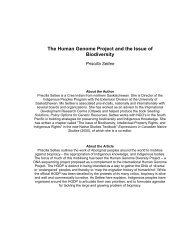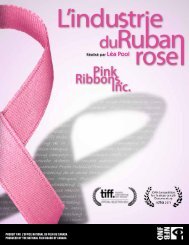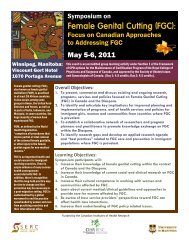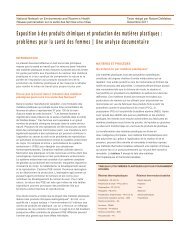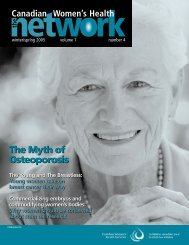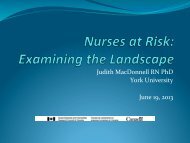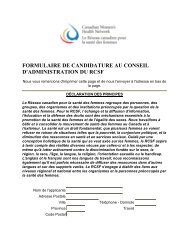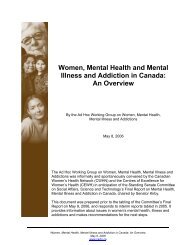social support, and self-esteem. Onthe other hand, the potential negativeconsequence of employment on healthalso exist, such as the stressesassociated with the ‘double day,’ orthe psychological, physical, and/orchemical hazards of a particular workenvironment. Furthermore, much of theevidence on women, work and healthis based on cross-sectional studies,making it difficult to differentiatebetween ‘healthy worker effects’and/or employment as contributingto better health. 52In their work analyzing the NationalPopulation <strong>Health</strong> Survey (1994) dataon this question, Denton and Waltersconcluded that their findings supported theliterature on the health benefit to women ofworking outside the home. Contrary to theidea that caring for children would addto the stress and workload of womenand possibly diminish their health, theyfound an association between betterfunctional health and women working a“double day” of paid employment andcaring for children. In trying to understandwhy this occurs, they hypothesized that:It may be that the ‘double day’,through role enhancement, promoteshealth, at least for some women. Ort<strong>here</strong> may be a selection effect suchthat only physically healthier womenare able to take on such demandingroles. Indeed, both explanationsmay be relevant. 535. Inequalities and the<strong>Health</strong> of Aboriginal WomenWomen, Income and<strong>Health</strong> in Manitoba285.1 JURISDICTIONAL ISSUESJurisdictional issues, and their implicationsfor the provision of health care services,are a major issue in any discussion of thehealth of Aboriginal people.In 1867, the British North American Actplaced “Indians and lands reserved forIndians under full legislative authority of thefederal government, while at the same timeplacing health and social services underprovincial jurisdiction.” 54 Yet of all of thetreaties signed between the Crown andFirst Nations, only Treaty Number 6 madespecific reference to health care:In the event <strong>here</strong>after of the Indians...being overtaken by any pestilence,or by general famine, the Queen...will grant to the Indians assistance...sufficient to relieve them from thecalamity that shall befallen them...A medicine chest shall be kept at thehouse of each Indian Agent for theuse and benefit of the Indians. 55The Indian Act of 1876 obligated thefederal government to take responsibilityfor the provision of health care serviceson reserves. It stated that the federalgovernment had the responsibility to:prevent, mitigate and control thespread of diseases on reserves...toprovide medical treatment and healthservice for Indians, to providecompulsory hospitalization andtreatment for infectious diseases...and to provide for sanitaryconditions...on reserves. 56The Government of Canada currentlyprovides health care services only toAboriginal people living on reserves. It hasargued that because “all Native people areincluded in the calculation of transferpayments to the provinces, Natives shouldbe afforded the same health servicesavailable to other provincial residents.” 57<strong>Health</strong> services on reserves are providedby the Medical Services Branch of <strong>Health</strong>Canada. Other government services on
Women, Income and<strong>Health</strong> in Manitoba29reserve are provided by Indian andNorthern Affairs Canada.5.2 DATA ISSUESThe National Forum on <strong>Health</strong> noted thatAboriginal women face a heightened risk ofa wide range of health problems includingboth increased morbidity and mortality. 58Yet, data about the health of Aboriginalpeople is scarce. This was noted in the1999 Statistical Report on the <strong>Health</strong> of<strong>Canadian</strong>s, which stated in part:One issue that cuts across almostall sections, however, is the relativepaucity of data on Canada’s Aboriginalpopulation and on marginalizedgroups such as street people. Whilemost of the topics in this Reportdescribe at least 97% of the<strong>Canadian</strong> population, it is importantto remember that the missing 3%often have a disproportionateshare of health problems. 59Aboriginal people, including Aboriginalhealth professionals have strong views onthe collection of health data. In March 1999,the <strong>Health</strong> Canada’s Advisory Committeeon Women’s <strong>Health</strong> Surveillance held aworkshop to discuss the development ofits plan of action.Dr. Judith Bartlett, of the Aboriginal <strong>Health</strong>and Wellness Centre of Winnipeg statedthe following during the closing plenarysession:T<strong>here</strong> needs to be a separate orenhanced surveillance system forAboriginal peoples, particularly Métis,non-status and off-reserve FirstNation people. T<strong>here</strong> are no dataavailable except for those that areextrapolated from on-reserve FirstNations. The approach to issues andconcerns as expressed by the mixedgroup of women participating in thisWorkshop is not relevant or contextualto Aboriginal women (for example,the discussion of fatigue or stress).The approach to the disease entitiesmust be holistic; data needs to becollected within an Aboriginal frameworkand owned by Aboriginalpeople. Several years ago, a NationalAboriginal Women’s Conference heldin Winnipeg clearly reported that theydid not want to discuss specificdiseases (need to be holistic and lookat root causes), nor did they wishto discuss women’s health in theabsence of a discussion of men’shealth. Analysis of Aboriginal datamust not be undertaken withoutAboriginal participation – at alllevels – from initial determinationof research questions to dataanalysis, dissemination and resultantpolicy and program development.Additional rationale for specific focusand control of Aboriginal data lieswith the constitution. 60Given these reservations, the followinginformation is presented on the healthstatus of Aboriginal women.5.3 HEALTH STATUSAboriginal women have shorter lifeexpectancies than <strong>Canadian</strong> women asa whole. Data from Indian and NorthernAffairs Canada (which includes only thoseFirst Nations people whose names appearon the Indian Register maintained byIndian and Northern Affairs Canada)indicate that the life expectancy ofRegistered Indian women has increasedover time, from 65.9 years in 1975 to 75.7years in 1995. While the gap in lifeexpectancy between Registered Indianwomen and all <strong>Canadian</strong> women hasdecreased over time, it is still significant.In 1995, all <strong>Canadian</strong> women had anaverage life expectancy at birth of 81.4years. That is, they could be expected tolive almost six years more than RegisteredIndian women. 61
- Page 1 and 2: WOMEN, INCOME ANDHEALTH IN MANITOBA
- Page 3 and 4: TABLE OF CONTENTSPageA. EXECUTIVE S
- Page 5 and 6: EXECUTIVE SUMMARYTHE LINK between p
- Page 7 and 8: Women, Income andHealth in Manitoba
- Page 9 and 10: B. INTRODUCTIONMuch work has been d
- Page 11 and 12: Consistent with the majority of soc
- Page 13 and 14: Health and Well-Being of Children i
- Page 15 and 16: Women, Income andHealth in Manitoba
- Page 17 and 18: members of different visible minori
- Page 19 and 20: Women, Income andHealth in Manitoba
- Page 21 and 22: 3. How has the connection between i
- Page 23 and 24: E. INCOME AND THE HEALTH OF WOMEN -
- Page 25 and 26: Women, Income andHealth in Manitoba
- Page 27: majority of British households,rega
- Page 31 and 32: The following chart, based on a cha
- Page 33 and 34: marsh potatoes, berries, etc. As a
- Page 35 and 36: opportunities for women may beone o
- Page 37 and 38: 2. Manitoba Data - Income and Healt
- Page 39 and 40: CHART 3HEALTH CARE EXPENDITURES ON
- Page 41 and 42: 3. What Does This Mean?As in other
- Page 43 and 44: procedures. It is noteworthy that t
- Page 45 and 46: 2. The Commonwealth Secretariat -Mo
- Page 47 and 48: Women, Income andHealth in Manitoba
- Page 49 and 50: H. MAKING PUBLIC POLICY HEALTHIER F
- Page 51 and 52: against women and its consequences
- Page 53 and 54: 3.3 CHILD TAX BENEFITThe Government
- Page 55 and 56: Household Basic Rent Rent Including
- Page 57 and 58: If RHAs are open to suchcollaborati
- Page 59 and 60: APPENDIX 1:SUGGESTIONS FOR FUTURE R
- Page 61 and 62: Women, Income andHealth in Manitoba
- Page 63 and 64: APPENDIX 3:HEALTH SERVICE UTILIZATI
- Page 65 and 66: APPENDIX 4:INTERVIEWS WITH ABORIGIN
- Page 67 and 68: Women, Income andHealth in Manitoba
- Page 69 and 70: Women, Income andHealth in Manitoba
- Page 71 and 72: Women, Income andHealth in Manitoba
- Page 73 and 74: ELEMENT #11GENDER SENSITIVE TRAININ
- Page 75 and 76: Women, Income andHealth in Manitoba
- Page 77 and 78: ENDNOTES1. Sarlo, Christopher, “P
- Page 79 and 80:
ENDNOTES (continued)45. Arber, Sara
- Page 81 and 82:
ENDNOTES (continued)88. Mustard, Ca
- Page 83 and 84:
REFERENCES (continued)Clarke, H.F.
- Page 85 and 86:
REFERENCES (continued)Macintyre, Sa
- Page 87 and 88:
REFERENCES (continued)Vancouver/Ric


